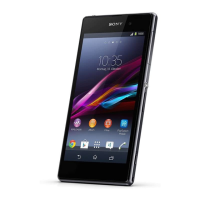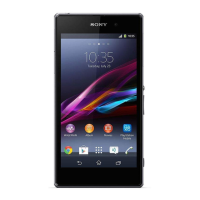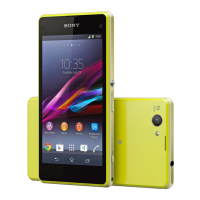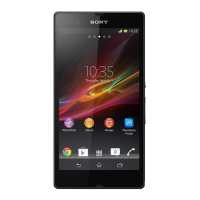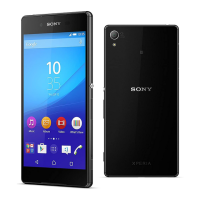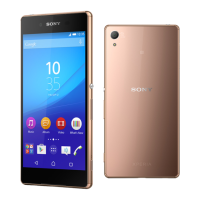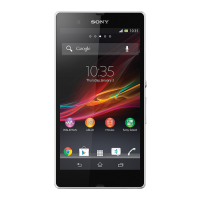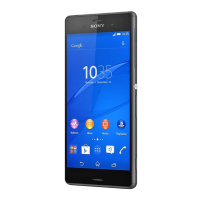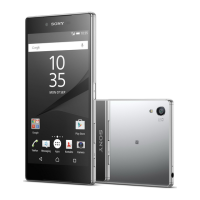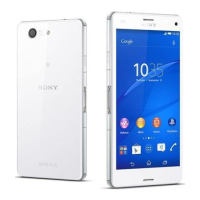Do you have a question about the Sony Xperia Z1 Compact D5503 and is the answer not in the manual?
Information about the Xperia Z1 Compact User Guide for Android 5.0.
Diagram and list of external device components and ports.
Instructions for inserting the micro SIM card and memory card.
Guide to turning the device on and off for initial setup.
Explains the benefits and necessity of a Google account.
Information on how to charge the device and battery.
Details on creating and managing user accounts on the device.
Explains basic touch gestures like tapping, touching and holding.
How to activate the screen and lock/unlock the device.
Introduction to the device's home screen and panes.
Navigating and managing applications on the device.
Using navigation keys, favorites bar, and recent apps.
Using miniature apps for multitasking and their management.
Adding, resizing, moving, and deleting widgets on the home screen.
Organizing apps on the home screen using shortcuts and folders.
Customizing the home screen with wallpapers and themes.
Instructions on how to capture still images of the device screen.
Capturing videos of on-screen activity for tutorials or gameplay.
Understanding and managing device notifications.
Explanation of status icons displayed in the status bar.
List and explanation of various notification icons.
Steps to download apps from the Google Play Store.
Enabling and installing apps from outside Google Play.
Using the Google Chrome browser for web access.
Configuring network settings for internet and multimedia messages.
Turning on, connecting to, and managing Wi-Fi networks.
Using USB or Bluetooth tethering and Wi-Fi hotspot.
Monitoring and managing mobile data consumption.
Manually choosing network modes like WCDMA or GSM.
Setting up and connecting to VPNs for secure network access.
Syncing data like contacts, email, and calendar with online services.
Setting up and managing Exchange ActiveSync accounts.
Syncing Outlook contacts and calendar via PC Companion.
How to access and manage device settings.
Adjusting volume levels, ringtones, and notification sounds.
Filtering and prioritizing notifications and setting interruption modes.
Locking and unlocking the SIM card with a PIN.
Adjusting screen brightness, touch vibration, and idle time.
Keeping the screen focused on a specific application.
Activating and configuring the interactive screen saver.
Setting up and changing screen lock types like PIN or pattern.
Changing the device language and input language.
Manually setting the date, time, and time zone.
Enhancing image quality for photos and videos.
Optimizing audio settings like ClearAudio+ and Dynamic Normalizer.
Using the QWERTY keyboard, gesture input, and one-handed keyboard.
Using the 12-key keypad for text input.
Using voice commands to enter text.
Selecting, cutting, copying, and pasting text.
Customizing keyboard settings like language and word suggestions.
Dialing numbers, using smart dial, and making international calls.
Answering or rejecting incoming calls.
Setting up and using the device's answering machine.
Managing calls in progress, including volume and call options.
Viewing missed, received, and dialed calls.
Directing calls to another number or answering service.
Blocking incoming or outgoing calls and setting up fixed dialing.
Handling multiple calls simultaneously with call waiting.
Setting up and managing multi-party conversations.
Accessing and managing voicemail messages.
Making emergency calls, even when the device is locked.
Methods to transfer contacts from old devices or online accounts.
Finding and managing contact information.
Creating new contacts and modifying existing ones.
Entering ICE (In Case of Emergency) details.
Marking contacts as favorites and assigning them to groups.
Sharing contacts via business card or individual contacts.
Linking or separating duplicate contact entries.
Saving contacts to a memory card or USB storage.
Creating, sending, and organizing text and multimedia messages.
Using Hangouts for real-time communication.
Configuring email accounts for sending and receiving messages.
Managing email inbox, reading, and composing messages.
Sorting, searching, and moving email messages.
Removing, modifying, and setting up auto-reply for email accounts.
Using the Gmail application for email.
Getting music files onto the device from a computer.
Using the Walkman application to play music and audio books.
Navigating the Walkman application interface.
Creating, playing, and managing music playlists.
Sharing songs, albums, and playlists with other devices.
Adjusting sound quality using Equaliser and Surround Sound.
Adding visual effects to music playback.
Identifying songs playing in the surroundings.
Tuning into FM stations and managing channels.
Saving and accessing favorite radio stations.
Switching between mono/stereo sound and selecting radio region.
Basic camera operations for capturing photos and videos.
Using face detection for automatic focus.
Enabling geotagging to add location data to photos.
Overview of capturing modes and general settings.
Adjusting resolution, self-timer, focus modes, HDR, ISO, and metering.
Configuring video resolution, self-timer, focus modes, and HDR video.
Browsing and viewing photos and videos in the Album application.
Sharing, rotating, deleting, and organizing media files.
Applying effects, cropping, and adjusting photos.
Trimming and adjusting video speed using Movie Creator.
Hiding and unhiding media files from the Album home screen.
Navigating albums and online content.
Viewing geotagged photos on a map or globe.
Playing videos, using playback controls, and external device playback.
Automatically creating short videos from photos and videos.
Buying and renting movies and TV shows.
Connecting the device to a TV via MHL or HDMI for viewing content.
Using Wi-Fi Direct (Miracast) for wireless screen sharing.
Viewing or playing media content on other DLNA devices.
Using a USB Host adapter to connect external storage devices.
Pairing the device with a wireless game controller.
Using Near Field Communication for data sharing and tag scanning.
Turning on, naming, and pairing the device with Bluetooth devices.
Automatically launching features via NFC between Xperia devices.
Automating actions based on accessory connection or time.
Connecting with ANT+ compatible health and fitness devices.
Making mobile payments using NFC.
Enabling and configuring location services for apps.
Tracking location, viewing traffic, and getting directions.
Activating data roaming for internet access abroad.
Connecting to car systems via USB for MirrorLink™.
Turning off wireless radios to save battery and prevent interference.
Managing schedules, creating events, and viewing multiple calendars.
Setting alarms, using the clock, stopwatch, and timer.
Accessing help, troubleshooting guides, and software update info.
Using PC Companion and Sony Bridge for Mac for device management.
Installing software updates wirelessly or via computer.
Using my Xperia service to locate and secure a lost device.
Viewing the device's IMEI number.
Monitoring battery consumption and using power saving modes.
Managing internal storage, memory cards, and RAM.
Transferring and managing files via USB connection.
Backing up and restoring data to a computer or storage device.
Performing specific or full diagnostic tests on device functions.
Forcing device restart or performing a factory data reset.
Guidelines for using the device in water and dust, and IP ratings.
Explanation of the device's water and dust resistance ratings.
Information on recycling the device responsibly.
Notes on service availability, data charges, and feature limitations.
| Processor | Qualcomm MSM8974 Snapdragon 800 |
|---|---|
| RAM | 2 GB |
| Internal Storage | 16 GB |
| Front Camera | 2 MP |
| Operating System | Android 4.3 (Jelly Bean), upgradable to 5.1 (Lollipop) |
| Dimensions | 127 x 64.9 x 9.5 mm (5.0 x 2.56 x 0.37 in) |
| Weight | 137 g (4.83 oz) |
| SIM | Micro-SIM |
| Network | GSM / HSPA / LTE |
| GPU | Adreno 330 |
| Card Slot | microSD, up to 64 GB |
| Main Camera Features | LED flash, HDR, panorama |
| Video | 1080p@30fps |
| Loudspeaker | Yes |
| 3.5mm Jack | Yes |
| WLAN | Wi-Fi 802.11 a/b/g/n/ac, dual-band, Wi-Fi Direct, DLNA, hotspot |
| Bluetooth | 4.0, A2DP, aptX |
| GPS | Yes, with A-GPS, GLONASS |
| NFC | Yes |
| Sensors | Accelerometer, gyro, proximity, compass |
| Colors | Black, White, Pink, Lime |
| Models | D5503 |
| Display | 4.3 inches, 720 x 1280 pixels |
| Rear Camera | 20.7 MP |
| Battery | 2300 mAh |
| IP Certification | IP58 |
| Radio | FM radio |
| USB | microUSB 2.0 (MHL TV-out) |
| Talk Time | Up to 18 h (2G) |
